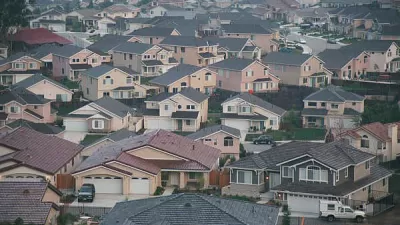Liam Dillon has written the exact article for anyone who has every rolled their eyes at the words "housing element" or Regional Housing Needs Assessment.

"Liam Dillon reports on the failure of California's Regional Housing Need Allocation (RHNA) law, which has been in place since 1967 but has done almost nothing to mitigate the state's deep housing crisis.
"The law requires cities and counties to produce prodigious reports to plan for housing — but it doesn’t hold them accountable for any resulting home building," explains Dillon of the fundamental shortcoming of the law. Foster City Councilmember Herb Perez described the city's housing policies, in reaction to the state law, in more frank terms at a 2015 City Council meeting, calling it an elaborate shell game. "Because we’re kind of lying," said Perez. "It’s the only word I can come up with. We have no intention of actually building the units."
Dillon is revisiting the debate about the RHNA law because the state is currently considering legislation that would "force cities and counties that have fallen behind on their housing goals to take steps to eliminate some of the hurdles they put in front of development, such as multiple planning reviews for individual projects." The legislation, by State Senator Scott Weiner (D-San Francisco) has cleared the State Senate "and is awaiting a vote in the Assembly as part of a package of bills aimed at addressing the state’s housing problems," reports Dillon.
After addressing the shortcomings of the RHNA law at the conceptual level, Dillon also drills down on the outright abuses, and some of the more casual neglect, that local governments get away with in meeting the requirements of the RHNA.
FULL STORY: California lawmakers have tried for 50 years to fix the state's housing crisis. Here's why they've failed

Manufactured Crisis: Losing the Nation’s Largest Source of Unsubsidized Affordable Housing
Manufactured housing communities have long been an affordable housing option for millions of people living in the U.S., but that affordability is disappearing rapidly. How did we get here?

Americans May Be Stuck — But Why?
Americans are moving a lot less than they once did, and that is a problem. While Yoni Applebaum, in his highly-publicized article Stuck, gets the reasons badly wrong, it's still important to ask: why are we moving so much less than before?

Using Old Oil and Gas Wells for Green Energy Storage
Penn State researchers have found that repurposing abandoned oil and gas wells for geothermal-assisted compressed-air energy storage can boost efficiency, reduce environmental risks, and support clean energy and job transitions.

Minneapolis Bans Rent-Setting Software
Four cities have enacted restrictions on algorithmic software that can inflate rent costs.

Oakland to Add 244 New EV Chargers
Oakland plans to launch its new charging network at eight locations by the end of 2025.

Jane Goodall Inspires with Message of Hope, Resilience, and Environmental Action
Speaking in Pasadena, Jane Goodall offered a hopeful and inspirational message, urging global compassion, environmental responsibility, and the power of individual action to shape a better future.
Urban Design for Planners 1: Software Tools
This six-course series explores essential urban design concepts using open source software and equips planners with the tools they need to participate fully in the urban design process.
Planning for Universal Design
Learn the tools for implementing Universal Design in planning regulations.
Heyer Gruel & Associates PA
City of Moreno Valley
Institute for Housing and Urban Development Studies (IHS)
City of Grandview
Harvard GSD Executive Education
Salt Lake City
NYU Wagner Graduate School of Public Service
City of Cambridge, Maryland





























